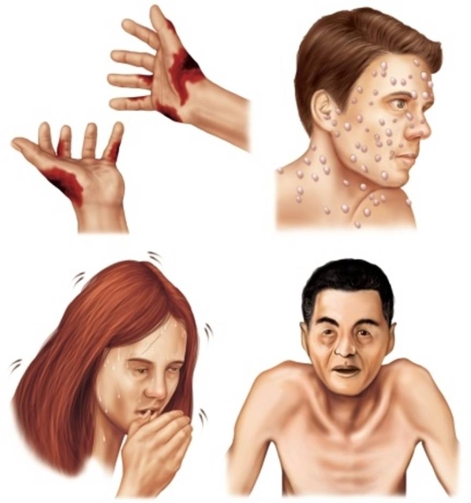A) respiratory arrest by blocking oxygen absorption.
B) coughing, nausea, and vomiting.
C) nerve damage in the trachea, lungs, and bronchi.
D) pulmonary edema and result in asphyxiation.
Correct Answer

verified
Correct Answer
verified
Multiple Choice
A dirty bomb is
A) a combination of a radioactive material and an explosive.
B) a combination of flammable materials that resist extinguishing efforts.
C) an explosive bomb filled with shrapnel and chemical gases.
D) a bomb that is purely radiological without an explosive.
Correct Answer

verified
Correct Answer
verified
Multiple Choice
Which is an example of a Category C disease or agent?
A) Hantavirus
B) Glanders
C) Viral Hemorrhagic Fever
D) Enterotoxin B
Correct Answer

verified
Correct Answer
verified
Multiple Choice
When arriving on a WMD scene, you should park your vehicle in a location that
A) is on even terrain with the contaminated scene.
B) prevents an on-rush of contaminated victims.
C) has a zero or negligible wind speed.
D) is as close to the hot zone as possible.
Correct Answer

verified
Correct Answer
verified
Multiple Choice
En route to a multiple casualty incident, EMS dispatch radios that the scene has a confirmed use of a chemical agent. Your vehicle is only equipped with gloves and face shields, and you will be one of the first responders. You should
A) secure a perimeter and ensure the walking wounded remain in the hot zone.
B) enter the scene and search for evidence indicating a secondary explosive.
C) enter the scene and begin a triage assessment of victims.
D) secure a perimeter and stop people from exiting and entering the scene.
Correct Answer

verified
Correct Answer
verified
Multiple Choice
A Category B disease or agent has
A) a high death rate.
B) a low death rate.
C) a 100% death rate.
D) a moderate death rate.
Correct Answer

verified
Correct Answer
verified
Multiple Choice
What are the main categories of weapons of mass destruction?
A) Biological, psychotropic, incendiary, explosive, and radiological
B) Psychotropic, radiological, chemical, anti-matter, and nuclear
C) Incendiary, nuclear, biological, explosive, and chemical
D) Virulent, bacterial, anti-matter, explosive, and incendiary
Correct Answer

verified
Correct Answer
verified
Multiple Choice
Before beginning care at the scene of a terrorist attack, you must ensure that
A) there is a reasonable search for secondary explosive devices.
B) available information is gathered from the walking wounded.
C) responders are made aware of important evidence.
D) your team understands the precise layout of the location.
E) All of these are correct.
Correct Answer

verified
Correct Answer
verified
Multiple Choice
The four types of biological weapons, pictured here, are

A) toxins, poisons, microbes, and viruses.
B) fevers, rickettsia, prions, and bacteria.
C) bacteria, viruses, rickettsia, and toxins.
D) prions, fevers, microbes, and poisons.
Correct Answer

verified
Correct Answer
verified
Multiple Choice
Which is an example of an incendiary weapon?
A) Pipe Bombs
B) Molotov cocktails
C) Dirty Bombs
D) Grenades
Correct Answer

verified
Correct Answer
verified
Multiple Choice
Before approaching a contaminated patient, you must
A) have established the NIMS.
B) identify the contaminant.
C) assess the mental status of the patient.
D) be equipped with proper PPE.
Correct Answer

verified
Correct Answer
verified
Multiple Choice
What are the three types of radiation shown in this picture?

A) Infrared, microwave, radio
B) X-ray, gamma, and ultraviolet
C) Alpha, omega, delta
D) Gamma, beta, and alpha
Correct Answer

verified
Correct Answer
verified
Multiple Choice
What is an important difference between a hazardous materials incident and a terrorist attack?
A) A hazardous materials incident does not involve the public, and a terrorist attack does involve the public.
B) A hazardous materials incident usually needs Level A PPE, and a terrorist attack usually needs Level D PPE.
C) A hazardous materials incident is accidental, and a terrorist attack is deliberate.
D) A hazardous materials incident needs NIMS, and a terrorist attack needs FBI coordination.
Correct Answer

verified
Correct Answer
verified
Multiple Choice
Which is an example of an explosive device?
A) A Molotov cocktail
B) A tear gas canister
C) A fire bomb
D) A car bomb
Correct Answer

verified
Correct Answer
verified
Multiple Choice
Weather conditions are likely to affect
A) the terrorist's decision to detonate a bomb.
B) the dispersal and spread of airborne agents.
C) the effectiveness of disaster response.
D) the type of WMD that is used.
Correct Answer

verified
Correct Answer
verified
Multiple Choice
Which finding would elevate your suspicion of a nerve agent attack?
A) A victim with debris on their clothes
B) A victim experiencing difficulty breathing
C) A victim with abnormal limb positioning
D) A victim experiencing a seizure
Correct Answer

verified
Correct Answer
verified
Multiple Choice
With the use of a WMD, you should NEVER:
A) feel anxious or overly scared.
B) rush headlong into the scene.
C) talk to media or journalists.
D) None of these are correct.
Correct Answer

verified
Correct Answer
verified
Multiple Choice
In which situation might you likely suspect the possible use of a biological weapon?
A) Hospitals report an unusually high number of ill patients, each with different symptoms.
B) A school is quickly swept by a flu-like illness, resulting in canceled classes.
C) Residents report an alarming number of crows appearing sick or dying.
D) A resident reports that their previously healthy dog suddenly became ill and died.
Correct Answer

verified
Correct Answer
verified
Multiple Choice
Which is an example of a Category B disease or agent?
A) Ricin
B) Nipah Virus
C) Smallpox
D) Tularemia
Correct Answer

verified
Correct Answer
verified
Multiple Choice
Most terrorist attacks involve the use of
A) explosive devices.
B) biological agents.
C) incendiary devices.
D) chemical agents.
Correct Answer

verified
Correct Answer
verified
Showing 21 - 40 of 42
Related Exams